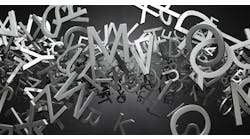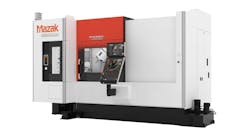A cylindrical grinding machine manufacturer delivers production and precision one modular building-block system at a time.
The S32 and S140 are the newest members in Studer's family of modular-building-block machines. Both systems inherit design characteristics from previous models and are geared for high-production grinding.
Modular builds have caught on in the machining world, and grinding machines are no exception. For instance, Studer has built on the platforms of its tried-and-true grinders to create two new cylindrical models. But in this modular building-block system, the size of machine components aren't the only thing that change from one machine to the next. The Swiss company also arranges common components in different configurations and adds special extras to meet specific production needs.
The new S32cnc external cylindrical grinder, for example, inherits features from the S21/S31 models launched in 1998. The S32's wheelhead design is borrowed, but Studer now mounts it in three different ways.
Wheelheads rest on the X-axis cross slide, which is factory-positioned at either 30° for angular infeed or at 0° (wheel on left or right) for straight infeed grinding. Its spindle is from the S31 series but now packs a built-in, mechanical balancing unit. It also handles wheels up to 500 mm in diameter.
Most balancers, says Hans Ueltschi of United Grinding Technologies Inc., the company that handles Studer machines in the U.S., are attached to either the wheel or adapter flange and offered as an option. Studer's spindle-integrated system reduces the price of the machine and makes for a more simple design. The reason? Less gadgets attached, says Ueltschi.
Diamond roll dressing run as an NC axis compliments the S32's wheelhead. The machine's control automatically adjusts the dresser in either synchronized or reverse-rotation with programmable speed.
Conventionally, a single-point or rotary tool mounted on the worktable does the wheel dressing from the front of a machine. As a special touch, the S32's dresser mounts behind the wheel, opposite where grinding takes place. Dressing with a pre-formed diamond roll that matches the grinding wheel profile further increases the speed of the process.
According to Ueltschi, a typical dressing cycle can take from 30 to 60 sec. The S32's cycle, which takes just 5 to 10 sec, then becomes insignificant during high-volume production jobs. This is because dressing is done as the wheels move away from the workpiece and isn't calculated into the part cycle time. This type of dresser is a first for Studer's midrange, medium-size machines.
Preloaded hydrostatic guide-ways on the S32's X and Z axes negate stick-slip and provide highly accurate positioning. Both axes are highly dynamic and digital, featuring direct drives and high-resolution measurement systems. The Z axis is prestressed and comes with Studer-developed Granitan S200 guideways and continuous lubrication. As for the machine's compact base, it too is made from Granitan and adapts to automatic robot systems.
A Fanuc 16i system controls a standard S32, but for form grinding, the company installs a Fanuc 160i control with an integrated PC and special software. Also for form grinding, the company supplies two versions of the C axis on the workhead spindle. The first is standard, and the second is high precision with a direct measuring system. The second configuration also has form and thread grinding cycles.
Besides running on some version of Fanuc's 16 series control, all Studers have the same software, called Pictogramming. This software, along with guided setup cycles, lets one trained operator run any Studer machine. This holds true with O.D., I.D., universal, or production-type systems. Users of single-purpose machines, says Ueltschi, get the same Pictogramming software as shops with more complex grinders. This same software can also be used off-line, in a Windows-format interface between the operator and machine's control.
More modular building
Studer's new S140cnc internal cylindrical grinding machine springs from the company's S145 universal internal cylindrical grinder design. The S140 expands the range of internal part processing capacity from small to medium/large size (40 kg). But, more importantly, it maximizes precision and productivity by incorporating up to three grinding spindles arranged on a single slide block.
The S140 shares the same workhead and tooling (chucks, collets, and so forth) with all of Studer's other models, except the smaller machines. In fact, workheads are now common among the S31, S32, S36, S40, S60, and S145. Machine tailstocks, along with taper adjustments, are also consistent throughout the Studer line.
A mechanical device on each tailstock controls taper for grinding such things as arbors. It makes slight adjustments, as small as 10 millionths of an inch, and is useful on machines without B axes.
Basically, Studer used its S145 as a "technological base" for the S140, but has improved on it, says Ueltschi.
As an individually extendable modular design machine, the basic S140 starts with a single grinding wheel spindle, dresser, linear measuring, and CNC. Both linear axes are pretensioned and hydrostatically controlled with digital direct drives. The basic S140 gets its control and electrical systems from Studer's S21cnc grinding machine.
According to Studer engineers, the most important element to the whole machine is its robustness. The machine base is Granitan and thermally insulated from the work area and electrical cabinet. It easily supports the S140 as a full-blown system with three spindles.
Another design quality Studer is passing from one machine generation to the next is the use of multiple spindles. The company's S40, for example, is an O.D. machine that can sport three wheels. Likewise, the new S140 is the only I.D. grinder offered with more than one spindle.
S140 wheelhead spindles, to some extent, are common between Studer's S31/21, S40, and the S145. The difference is that Studer takes the S140 beyond the common platform and offers an array of spindles. In I.D. grinding, this is important because a change in part diameter size means a change in wheel size and different spindle speeds.
On the S140, shops can change spindle type after a machine is purchased, or they can specify beforehand. For complete, single-setup jobs, the S140 does both external and internal grinding. A three-spindle configuration may include two I.D.s and one O.D. wheel. Or it might have all three as I.D. wheels.
The I.D./O.D. mix lets shops easily grind part faces using the O.D. wheel, the same as on an external cylindrical machine. Having three I.D. wheels, according to Ueltschi, is perfect for shops grinding parts with a lot of different bore sizes, tapers, or seats. For example, a shop could set up its machine with both a 1 /4-in. I.D. wheel, reserving the third wheel for tapers. With three wheels at their disposal, shops not only finish parts in one setup, but also reduce runout between bores and seats. Holding this concentricity is especially important on such parts as diesel fuel injectors.
The same but different
Lee's Grinding Inc. holds submicron part tolerances on its Studer S40 universal cylindrical grinder. The machine shares some common features with Studer's new S140 and S32 models.
According to James Spencer of Lee's Grinding in Cleveland, the shop specializes in what he refers to as "the work no one else wants to do." These are jobs that call for extremely tight tolerances and high-quality finishes. Not only that, lot sizes can vary from one to a couple hundred-thousand pieces. All these reasons, says Project Manager Spencer, guided Lee's to a Studer S40cnc external cylindrical grinding machine. Although it shares the same multispindle design with Studer's new S140, the S40 is more of a jobshop machine, while the new model is geared toward high production.
At Lee's, tolerances that were once a tenth of a thousandth of an inch are now less than 40 millionths of an inch. And from week to week, parts vary. One day, it could be injector parts with submicron tolerances, and the next it's 30-in.-long shafts.
Lee's S40, purchased at the end of '99, includes options many average shops would pass on: a B-axis for doing non-round forms and threads, rotary diamond dresser for superabrasives, and three different I.D. spindles.
Lee's sets up its S40 with two O.D. wheels — a 16 and 20 in. — and an I.D. wheel. The company uses three types of I.D. spindles to handle all the different bore sizes it encounters. This is especially beneficial while doing prototype work, says Spencer.
The S40's universal swiveling wheelhead comes in three versions: a turret wheelhead, production wheelhead right, and production wheelhead left. It revolves on a Hirth serration with 1° increments. The wheel-head houses an internal grinding attachment with either an air-driven, high frequency, or belt-driven spindle.
A Fanuc series 16 control accepts programming for up to three grinding wheels to machine a single part. Studer's Pictogramming lets users generate programs easily. With it, operators join required grinding cycles to one another and enter necessary values. The control unit then generates the ISO program automatically. In addition, a PC can generate programs.





